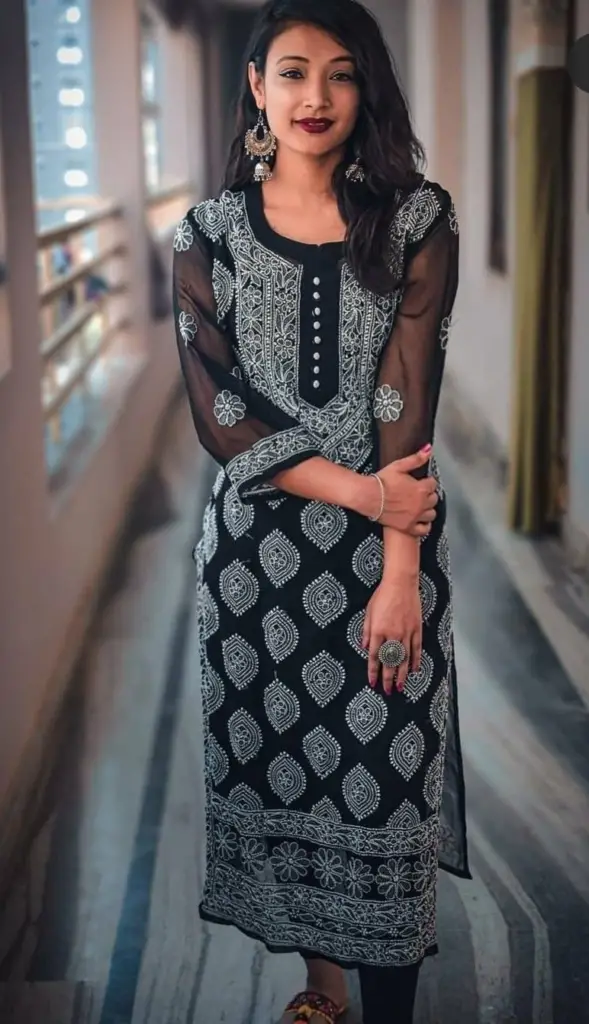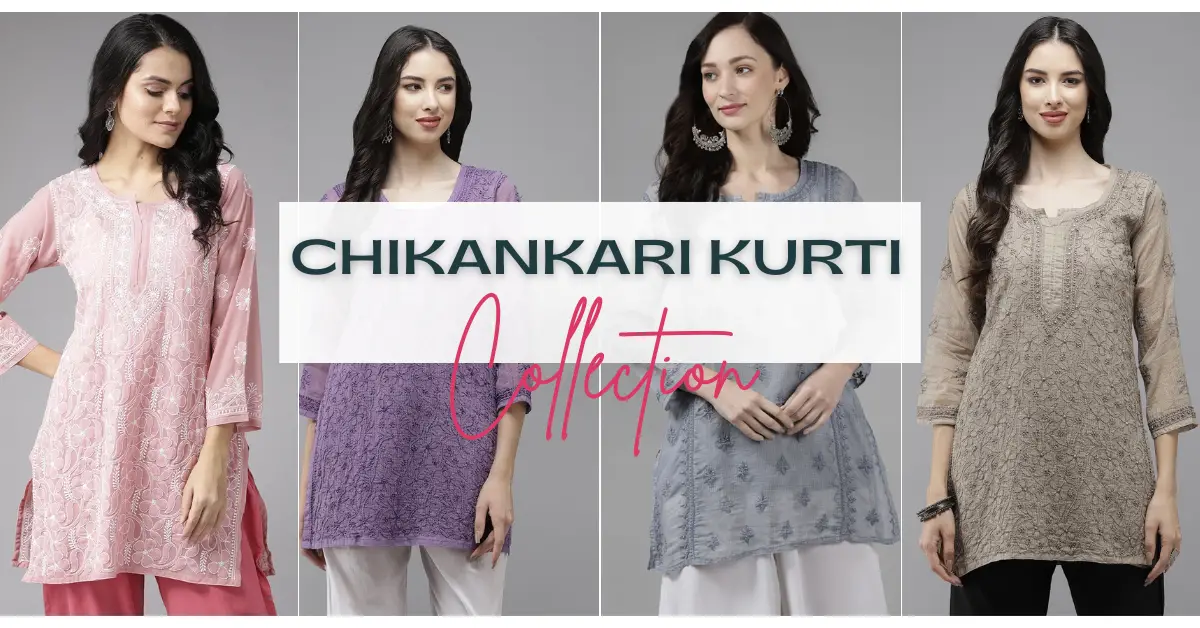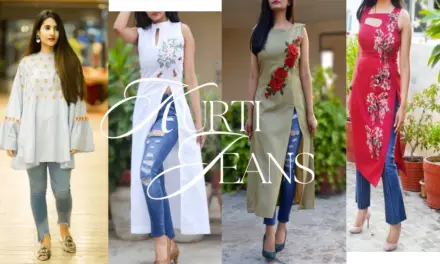How to Style chikankari kurti? Chikankari outfits are a beautiful and versatile addition to any wardrobe. Originally hailing from Lucknow, India, chikankari is a traditional art of embroidery that involves intricate and delicate needlework on various types of fabrics. These days, chikankari embroidery can be found on a wide range of clothing items, including different types of Kurtis, tops, dresses, and pants.
Not only do chikankari outfits add a touch of cultural flair to your look, but they are also suitable for a variety of everyday occasions. Whether you’re heading to work, school, or a casual outing, chikankari outfits offer a stylish and unique way to express your personal style. In this article, we’ll explore 6 stylish ways to wear chikankari outfits for everyday wear. also read BEST KURTI BRANDS IN INDIA.
Table outlining different outfit ideas
| Outfit Idea | Accessories | Bottom | Footwear |
|---|---|---|---|
| With Palazzos and statement jewelry | Statement Earrings, bangles | Palazzo pants | Heels or Sandals |
| With a long skirt and dupatta | Jhumkas, Bracelet | Long skirt | Flats or wedges |
| With denim jeans and statement earrings | Hoop earrings | Denim Jeans | Sneakers or loafers |
| With a saree and minimal jewelry | Stud earrings | Saree | Flats |
| With cigarette pants and a statement necklace | Statement necklace | cigarette pants | heels or flats |
| With a maxi skirt and a belt | statement ring | Maxi Skirt | Heels or flats |
As you can see, chikankari kurti can be paired with many different types of bottoms, footwear, and accessories to create a variety of different looks. And it is important to consider the occasion and dress code when selecting an outfit.
What is chikankari?
Chikankari is a traditional art of embroidery that originated in the city of Lucknow, located in the northern Indian state of Uttar Pradesh. The word “chikankari” is derived from the Persian word “chikan,” which means “a cloth with decorative needlework.” Chikankari embroidery involves the use of a variety of techniques, such as chain stitch, buttonhole stitch, and shadow work, to create intricate and delicate patterns on fabric.

Traditionally, chikankari embroidery was done by hand using a small hook-like needle called an aari. The embroidery was typically done on muslin or other lightweight fabrics, and the designs were created using white thread on white or pastel-colored fabric. Today, chikankari embroidery is still done by hand, but it is also done using machines, and the designs can be created using a variety of colors on different types of fabrics.
Techniques and materials used in chikankari embroidery
Chikankari is a traditional embroidery technique that originated in the city of Lucknow, India. It involves intricate and delicate needlework using white thread on lightweight fabrics such as muslin, chiffon, and organza.
There are several techniques used in chikankari embroidery, including:
- Shadow work: This is a form of cutwork embroidery in which the fabric is cut away in a pattern and the embroidery is done on the underside of the fabric to create a shadow effect.
- Chain stitch: This is a basic embroidery stitch that is used to create a continuous line of stitches.
- Buttonhole stitch: This is a variation of the chain stitch that is used to create a decorative edge on the fabric.
- Satin stitch: This is a flat, smooth embroidery stitch that is used to fill in large areas of the fabric.
- Stem stitch: This is a decorative embroidery stitch that is used to create curved lines and outlines.
Six stylish ways to wear chikankari outfits for everyday occasions:
- Chikankari kurta with jeans: Pair a chikankari kurta, which is a long tunic, with a pair of jeans for a casual and comfortable look. You can also add a belt to define your waist and create a more polished look.
- Chikankari palazzo pants with a solid-colored top: Palazzo pants are a comfortable and stylish option for everyday wear. Pair them with a solid-colored top and some statement jewelry for a chic and effortless look.
- Chikankari maxi dress: A chikankari maxi dress is a versatile and stylish option for everyday wear. You can wear it with sandals or heels, depending on the occasion.
- Chikankari dupatta with a solid-colored suit: A chikankari dupatta, which is a long scarf, can add a touch of traditional elegance to a solid-colored suit. You can drape it over your shoulders or wear it as a headscarf for a unique and stylish look.
- Chikankari lehenga with a crop top: A chikankari lehenga, which is a skirt with a long trail, can be dressed up or down depending on the occasion. Pair it with a crop top and some statement jewelry for a chic and fashionable look. you can check for more here TYPES OF LEHENGA & HOW TO CHOOSE ACCORDING TO NEEDS
- Chikankari saree with a blouse: A chikankari saree is a classic and elegant option for everyday wear. You can pair it with a blouse in a coordinating color and some simple jewelry for a stylish and sophisticated look.
Different chikankari pieces, such as kurtis, tops, dresses, and pants
- Chikankari kurtis: A kurti is a long tunic that is typically worn with pants or leggings. It is a versatile and comfortable option for everyday wear.
- Chikankari tops: Chikankari tops can be worn with pants, skirts, or skirts for a stylish and casual look.
- Chikankari dresses: Chikankari dresses can be worn in a variety of styles, including maxi dresses, shift dresses, and fit-and-flare dresses.
- Chikankari pants: Chikankari pants can be worn with a variety of tops, including kurtis, tops, and tunics. They are a comfortable and stylish option for everyday wear.
- Chikankari dupattas: A dupatta is a long scarf that can be worn with a variety of outfits, including suits, kurtis, and lehengas. It can be draped over the shoulders or worn as a headscarf for a traditional and elegant look.
- Chikankari lehengas: A lehenga is a skirt with a long trail that is typically worn with a blouse and dupatta. It is a traditional and formal option for special occasions.
Tips on how to accessorize and pair chikankari outfits with other pieces
- Add statement jewelry: Chikankari outfits can be dressed up or down with the right accessories. Consider adding some statement jewelry, such as earrings, bangles, or a necklace, to elevate your look.
- Choose coordinating colors: When pairing chikankari outfits with other pieces, it is important to choose coordinating colors. For example, if you are wearing a chikankari kurti, you can pair it with pants or leggings in a coordinating color, such as black, white, or navy.
- Experiment with layering: Layering can add texture and interest to your look. Try layering a chikankari dupatta over a solid-colored suit, or pairing a chikankari kurti with a cardigan or jacket.
- Choose the right shoes: The right shoes can complete your look and make a statement. If you are wearing a chikankari maxi dress, for example, you can pair it with sandals or heels depending on the occasion.
- Play with proportions: Experiment with different proportions to create a balanced and stylish look. For example, if you are wearing a chikankari lehenga, you can pair it with a fitted blouse to balance out the volume of the skirt.
Various styles and fits of chikankari outfits are available
There are a wide variety of styles and fits available for chikankari outfits, including:
- Traditional styles: Traditional chikankari outfits often feature a more formal and elegant look, with intricate embroidery and a classic silhouette. These styles may include sarees, lehengas, and salwar kameez suits.
- Modern styles: Modern chikankari outfits often feature a more casual and relaxed look, with a focus on comfort and versatility. These styles may include kurtis, tops, dresses, and pants.
- Loose fits: Loose-fitting chikankari outfits are comfortable and easy to wear, making them a great option for everyday wear. These styles may include kurtis, tunics, and maxi dresses.
- Fitted styles: Fitted chikankari outfits are more form-fitting and can be dressed up or down depending on the occasion. These styles may include lehengas, sarees, and salwar kameez suits.
Tips for choosing the right size and fit for your body type
- Measure yourself: Before you start shopping, it is important to measure yourself accurately to determine your size. This will help you find clothes that fit properly and are comfortable to wear.
- Try clothes on: When shopping for chikankari outfits, it is important to try them on to see how they fit. This will give you a better sense of how the garment will look and feel on your body.
- Consider your body type: Different body types look best in different types of fits. For example, if you have an hourglass figure, you may want to look for chikankari outfits that cinch at the waist to highlight your curves. If you have an apple-shaped figure, you may want to look for chikankari outfits with a looser fit to balance out your proportions.
- Look for adjustable features: Some chikankari outfits come with adjustable features, such as drawstring waists or elasticized hems, which can help you achieve a better fit.
- Don’t be afraid to size up or down: It is important to remember that size labels are just a guide and may not always correspond to your body measurements. If you are in between sizes or are unsure about the fit, it is okay to size up or down as needed.
Importance of selecting high-quality chikankari embroidery
Selecting high-quality chikankari embroidery is important for several reasons:
- Durability: High-quality chikankari embroidery is more durable and less prone to wear and tear, so it will last longer and look better over time.
- Appearance: High-quality chikankari embroidery has a more polished and professional appearance, with precise stitches and a smooth finish.
- Comfort: High-quality chikankari embroidery is typically more comfortable to wear, as it is made with softer and more breathable fabrics.
- Value for money: While high-quality chikankari embroidery may cost more upfront, it is a worthwhile investment as it will last longer and retain its value over time.
Cleaning and storing chikankari outfits to preserve their beauty and longevity
Proper care is important for maintaining the quality and longevity of chikankari embroidery. Here are some tips for properly caring for chikankari embroidery:
- Wash gently: Chikankari outfits are made with delicate fabrics and intricate embroidery, so it is important to wash them gently. Avoid using hot water or harsh detergents, and consider using a gentle cycle on your washing machine or hand washing the garment.
- Avoid drying in direct sunlight: Sunlight can fade and weaken the fabric, so it is important to avoid drying chikankari outfits in direct sunlight. Instead, hang the garment in a cool, well-ventilated area.
- Iron on low heat: If you need to iron your chikankari outfit, use a low heat setting and avoid ironing over the embroidery itself. You can also use a pressing cloth to protect the embroidery from direct contact with the iron.
- Store carefully: When not in use, it is important to store your chikankari outfits carefully to protect them from damage. Avoid folding or creasing the garment, and consider using a garment bag or acid-free tissue paper to protect it from dust and moisture.
- Rotate your wardrobe: To help preserve the beauty of your chikankari outfits, consider rotating them regularly so that they are not worn too frequently. This will help prevent wear and tear and keep the garments looking fresh and new.
Conclusion:
In summary, chikankari embroidery is a traditional and intricate embroidery technique that originated in the city of Lucknow, India. It involves the use of various techniques, such as shadow work, chain stitch, and buttonhole stitch, to create intricate and delicate designs on lightweight fabrics. Chikankari outfits are available in a wide range of styles and fits, including traditional, modern, loose-fitting, and fitted styles.
To choose the right size and fit, it is important to measure yourself accurately, try clothes on, and consider your body type and any adjustable features.






Recent Comments